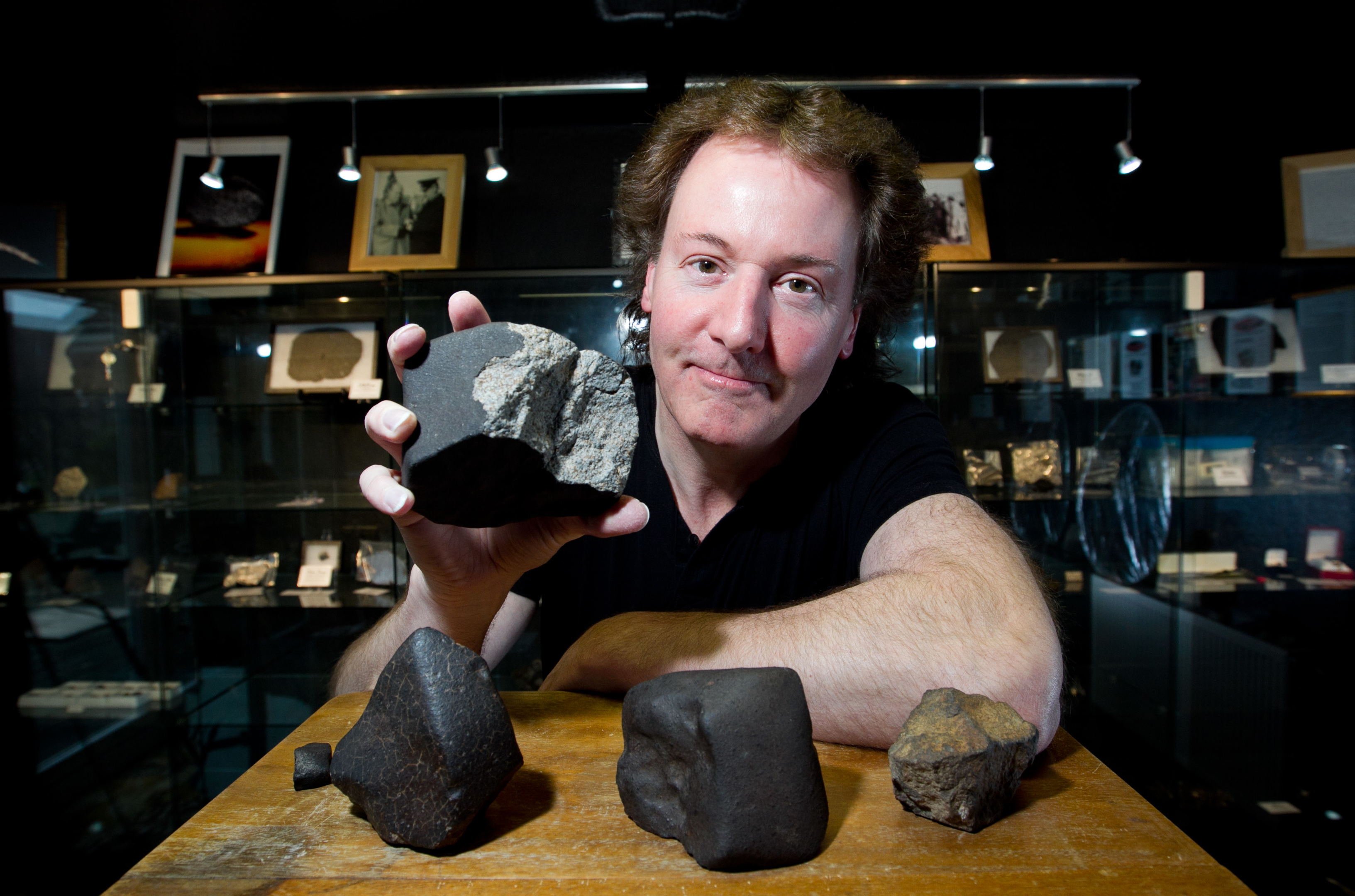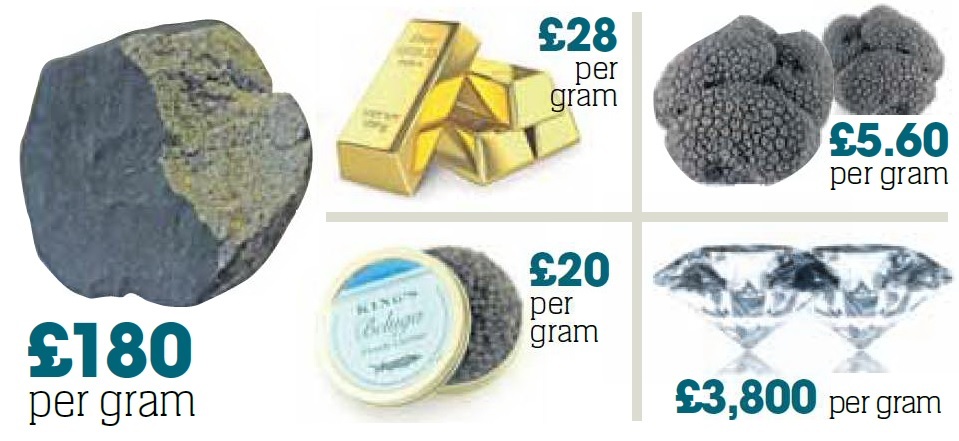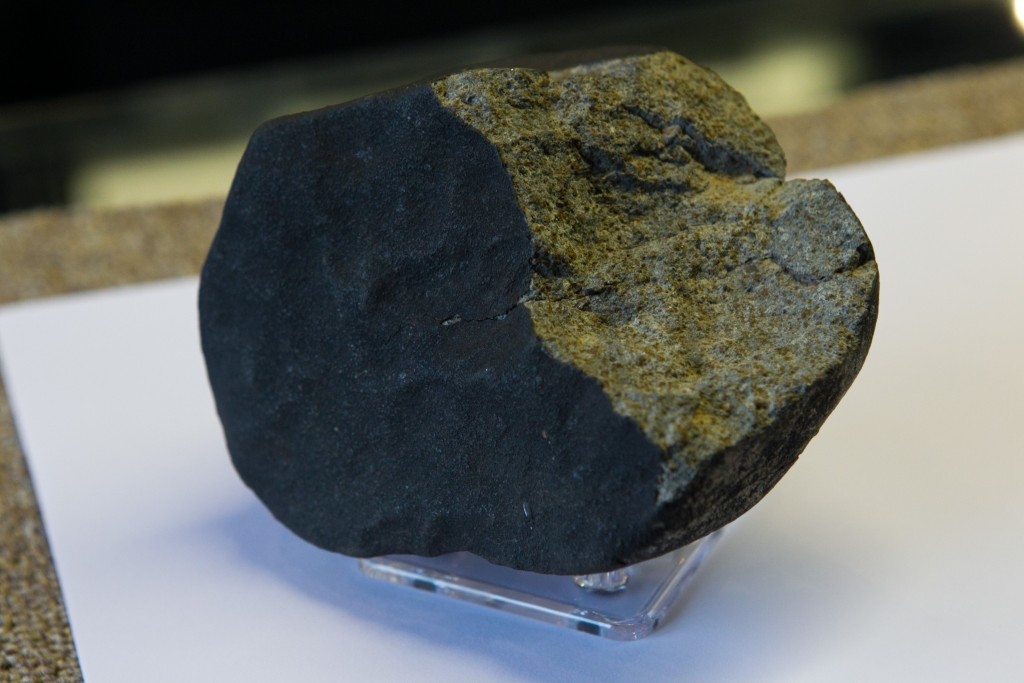
Rob Elliott has spent 20 years scouring the globe in search of cosmic rocks that have landed on earth.
The 55-year-old’s stellar dedication has seen him amass a collection once valued at £1 million.
Having already made enough to pay off his mortgage, he doesn’t sell them any more but focuses instead on collecting them.
And he’s offering a massive £10,000 reward to anyone who has part of the meteor which lit up the sky over Scotland last week.
Hundreds of people were startled when a shining streak of light flashed across the sky over the Borders.
Rob said if anyone could prove they had a chunk he would fork out an astronomical sum for it.
“I would happily put up a reward of £10,000 for a piece that was big enough for me to heft about in my hand,” he said.
“If the meteorite the other night was an apple-sized piece it would have put on a wonderful display but might not have survived the way to the ground.”
https://www.youtube.com/watch?v=O7L2_MzmDes
Rob said the fact last week’s display was apparently accompanied by “sonic booms” meant “something could have landed”.
“If someone did find a piece, I would be there within a couple of hours,” he added.
Finding a meteorite is no easy business – especially one that’s landed in the UK.
On a global scale the British isles are a relatively tiny object for a meteor to hit meaning those that do make it to Earth are highly valued.
“Scotland is a very small target to hit from space,” he explained. “That adds value because some people collect by locality.
“It would be attractive to collectors and to science.
“It’s been a long time since we had a meteor fall in Scotland.
“It would be highly collectible and would have a high value – especially if it hit something or came through someone’s roof.
“The value would go up because it would go down in history.
“There’s no set price. It’s all supply and demand.”
Top 5 meteor facts
1) A meteor is the streak of light which results when a meteoroid (a mass of rock and/or metal from space) enters the Earth’s atmosphere and disintegrates. Meteorites are the rocks that actually make it to Earth.
2) The Hoba meteorite in Namibia is the largest in the world. It fell about 80,000 years ago and weighs 66 tonnes.
3) This year, authorities in India suggested that a falling meteorite had killed a bus driver there. However, NASA later debunked the claims.
4) Most meteorites are one of three types: stony, stony-iron, or iron. These compositions tell us where the meteoroid existed in its parent body. An iron or stony iron was close to the core of an asteroid, while a stony object was closer to the surface.
5) The Allende Meteorite fell to Earth in 1969. Pieces were strewn across the Mexican state of Chihuahua. It dates back to the formation of the Sun and planets.
People from Angus to Inverness reported seeing the meteor that appeared to explode over Scotland.
Some startled witnesses were able to capture dramatic footage of the bright flash on car dashboard cameras and CCTV.
And it isn’t the only space rock coming close to Earth.
A 100ft-wide asteroid is set to pass by the planet today.
But don’t worry. The rock, named 2013 TX68, will miss us by 15,000 miles.
Finding pieces of space rock that do land here is hard.
But Rob has some tips people can use as a starting point.
Last week’s meteorite would have been travelling at between 25,000mph and 160,000mph when it hit the Earth’s atmosphere.
By the time it reached the ground it would have slowed to around 150mph.
This means it would have created an impact when it finally did reach the ground.
“The crater would likely be about the size of a golf hole and would have a rock inside it,” he said.
Rob has made hundreds of thousands of pounds selling meteorites since he first picked up the galactic bug two decades ago.
Some fetch as much as £180 per gram – more than six times the price of gold.
It all started when he spotted an advert in an astronomy magazine that offered readers the chance to “own a piece of another world”.
He duly sent off a cheque for a piece of a meteorite and was hooked when it eventually arrived in the mail.
That purchase was the first of many that would see him amass the largest private collection of meteorites in Britain.
Rob has had to give over an entire room in his home to house his collection.
Enterprising Rob took out an £80,000 bank loan to buy fragments of space rock – pieces of the Moon and Mars – which he gingerly cut up and sold on at a profit.
Since then he’s made enough to live comfortably with wife Irene, 53, in their home in the quiet Fife village of Milton of Balgonie.
Rob has “paid the mortgage off now” thanks to his canny wheelings and dealings.
After selling his space rocks to celebrities such as Queen guitarist Brian May, Michael Jackson and Uri Geller, he’s also been able to treat himself to things such as his Jeep – complete with the personalised number plate M8 EOR.
Rob – who studied electronic engineering before going on to work on military projects – has no regrets about leaving it all behind to search for space junk.
His most famous find was the Hambleton meteorite – an extremely rare stony-iron meteorite and the only one of its kind to be found in the UK.
A mere 2.9kg (6.4lb) slice of it was valued at up to £10,000.
Rob found it in 2005 on a walk with Irene while they were taking a holiday in North Yorkshire.
He also owns a piece of the Russian Chelyabinsk meteorite which caused widespread disruption, including blowing out the windows at a factory, when it exploded 15 miles above the city.
Rob admits former bank manager Irene doesn’t share his passion.
However, he doesn’t mind as her attitude helps prevent his hobby from becoming all-consuming.
He said: “Irene brings me down to earth.
“She keeps my feet firmly on the ground.”
What it’s worth

METEORITES are highly desirable and costly.
Some have sold for as much as £180 per gram, making them more expensive than precious metals and many luxury foods.
Traders offer people around £28 per gram for gold – a sixth of the price commanded by rare space rocks. Beluga caviar – the most expensive food in the world – sells for £20,000 per kilogram, working out at £20 per gram.
Another luxury eat – truffles – cost £2,530 a pound. But that’s just equivalent to around £5.60 a gram.
However, diamonds are the most expensive. They are priced per carat – a unit of weight used for precious stones and pearls.
The price for one-carat diamonds ranges between £2,000 and £19,000 per carat.
There are five carats in a gram meaning diamonds can cost between £400 and £3,800 per gram.
UK hot spots
YOUR best bet of finding a meteorite is to look where they’ve been found before as you may come across a fragment from the same rocks.
Here’s a list of where they’ve landed.
Glenrothes, Fife – Found in 1998. Landed long before then.
Strathmore, Angus – Fell in 1917. A fragment crashed through the roof of house.
High Possil, nr Glasgow – Fell in 1804.
Perth – Fell in the North Inch part of city in 1830.
Loch Tay, Perthshire – Several stones said to have fallen in 1802. However, the evidence is not conclusive.
Middlesbrough – Landed in 1881.
Crumlin, Co. Antrim – Landed in 1902.
Bovedy, Co. Derry – Fell in 1969. One fragment fell through a roof and broke in two while another landed in a farmer’s field.
Hambleton, Yorkshire – Discovered in 2005. Not known when it originally fell.
Wold Newton, Yorkshire – Second largest fall in the UK. Landed in 1795.
Appley Bridge, Lancashire – Fell in 1914.
Rowton, Shropshire – Fell in 1876.
Barwell, Leicestershire – Fell on Christmas Eve, 1965.
Wilsford cum Lake, Wiltshire – Early 1900s. Biggest meteorite ever found in Britain.
Glatton, Cambridgeshire – Fell in 1991. Pensioner found it in his garden.
Launton, Oxfordshire – Fell in 1830.
Ashdon, Essex – Fell on June 7, 1923.
Aldsworth, Gloucs – Fell in 1835.
Hatford, Berkshire – Fell in 1628.
Stretch Leigh, nr Plymouth – Fell in 1623.
READ MORE
Scotland leading the way to play host to UK’s first spaceport

Enjoy the convenience of having The Sunday Post delivered as a digital ePaper straight to your smartphone, tablet or computer.
Subscribe for only £5.49 a month and enjoy all the benefits of the printed paper as a digital replica.
Subscribe
